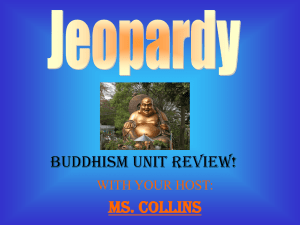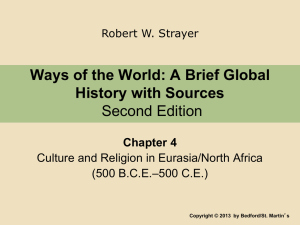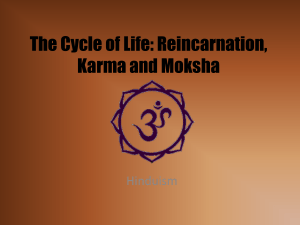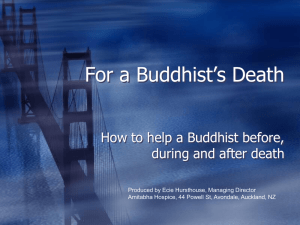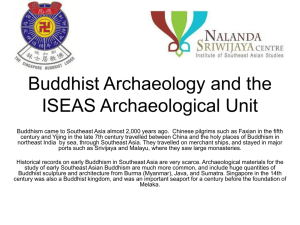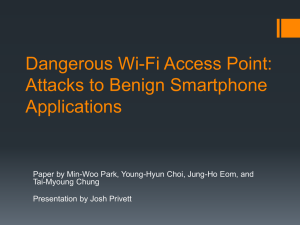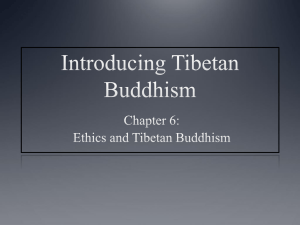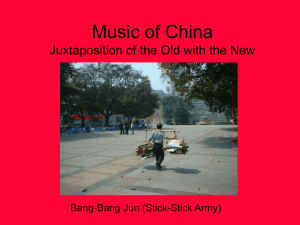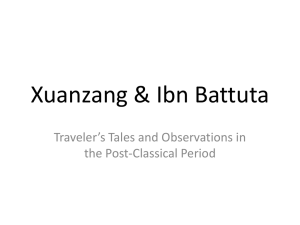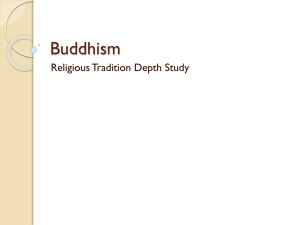Buddhist Empowerment & Life Transformation
advertisement
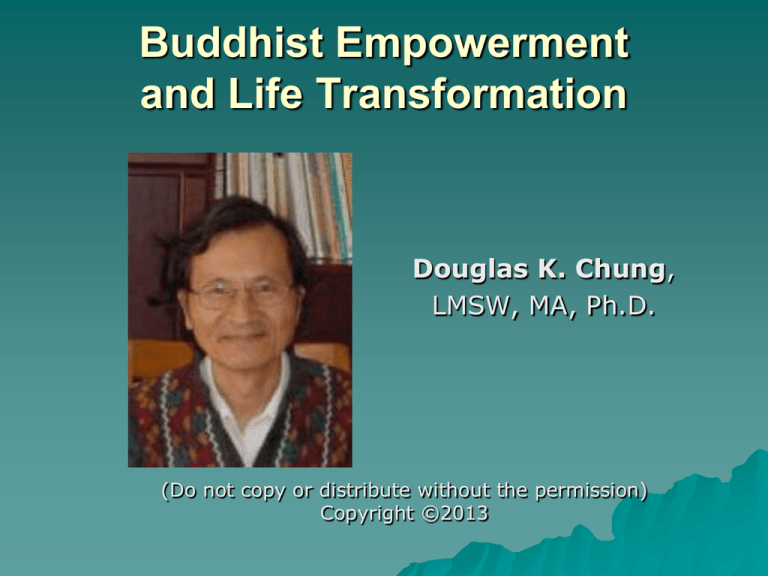
Buddhist Empowerment and Life Transformation Douglas K. Chung, LMSW, MA, Ph.D. (Do not copy or distribute without the permission) Copyright ©2013 Purposes of Workshop To learn Samsara concept of death in Buddhism for counseling and treatment model building. To study Good Deed Approach as life plan for empowerment and life transformation. To integrate the spirituality with life planning for life transformation. Siddhārtha Gautama Founder of Buddhism circa 563 BCE to 483 BCE * Various collections of teachings attributed to him were passed down by oral tradition, and first committed to writing about 400 years later. Buddhist Populations While estimates vary between 200-500 million adherents, the generally agreed number of Buddhists is estimated at around 350 million (6% of the world's population). This makes Buddhism the world's fourth largest (in terms of number of adherents) religion. http://www.buddhanet.net/e-learning/history/bud_statwrld.htm Buddhist Populations In the USA: – 301,139,947 (0.7% of the U.S. Population.) ("CIA The World Factbook – United States of America". Flagcounter.com. Retrieved 20 November 2011.) In Michigan (Census 2010) – 11,568. (0.01% of Michigan Population) (http://data3.tennessean.com/viewdatabase/religious-populations-by-state794/details/22.html) Buddhist Worldview All beings in this world are under Samsara: Samsara is considered as a life process. After a life passed, its “consciousness” will depart from the subject and went through certain process it may enter another new born subject. This new born subject may be human being, ghost, animal or god to reach Nirvana. Buddhist Worldview All beings in this world are under Samsara: Previous life’s Karma determined this current life situation Current life is an Outcomes of previous life & determine the future life as Person, ghost, or animal Future life is contingent upon the karma created in the current life Nirvana: out of cycle of Samsara. an ultimate state where free from samsara and enjoying everlasting ultimate being. (from Lu, Kevin “Discourse Analysis of Samsara in Buddhism Investigation by the Debate between Buddhist and Nihilist in Payasi Sutta) Buddhist Ideal State: Nirvana There be a state of being that free from the endless samsara that enjoying the everlasting of the ultimate – Nirvana that free from birth and death, old age and sorrow and attain immortality. This ideal state can be reached by engaging in self-realization goal for transforming the current life into higher quality of being through samsara. What is Buddhism? (Jayaram V 2012) Who is Buddha? An Indian who originally established Buddhism Focused on law & principles in life Self determination & self discipline. What is Buddhism? A belief system that intends to free people from doubt, karma, & bitterness in their lives and transform into an ultimate spiritual world of nirvana. Buddhism believes no soul while Hinduism – all beings posses souls Samsara – Wheel of Life Samsara is considered as a life philosophy to explain the causal dynamics of previous, current, & future lives as an endless process with an equal opportunity to transform into nirvana. IMAGE: http://en.wikipedia.org/wiki/File:Samsara.jpg What is Samsara? Buddhist Religious Mark After a life ended, its “consciousness” will depart from the subject and went through certain process it may enter another new born subject. This new born subject may be human being, ghost, animal or god to reach Nirvana. All living beings are transforming among the above mentioned world according to the principle of cause and effect and ethical moral order, then restart a new life. During the process, the current living situation is called current life, the previous transformed living situation is called previous life while the next transformed living situation is called future life. http://www.dedroidify.com/samsara.htm What is Samsara? (cont.) The current life is an outcome of the previous living condition while the future life is contingent upon the current living conditions according to cause effect principle in samsara. The quality and quantity of karma in one life determine the type & quality of next life. The memory of previous life will be deleted during the transformation process. The life goes through birth, age, illness, death & life after life as an endless cycling is called samsara. Process of Samsara in three lives Previous life’s Karma Positive vs. go vs. Nirvana (out of cycle) or Negative to person, ghost, animal Current life is an outcomes of previous life & determines the future life: – Nirvana (out of cycle) or Person, ghost, animal Future life is contingent upon the karma created in the current life. Offer another opportunity for next cycle’s life transformation – Nirvana (out of cycle) or Person, ghost, animal (Organized from Buddhist perspective of samsara (1982) Kaohsiung.) Historical Development of Samsara Rgveda: described soul conditions after death – did not mentioned about transform into other life. Brhdaranyaka Upanishads & ChAndogda Upanisad – 2 books confirmed concepts of cycles of previous, current & future life samsara Samsara became main stream in India Life is a continuous process – death is a beginning of another life. How to detach & transform into nirvana – key Two different views in debate (Lu, Kevin) Debate for Samsara in Buddhism: Two Rival View points(Lu, Kevin) Eternalism Samsara does exist (sassatavada – “normal bias” ) Upanisads used “self” as source of universal “real self” Easy to be accepted Annihilationism Samsara does not exist (ucchedavada “serious bias”) Question about 3 lives samsara validity Carried a negative reputation of moral order destruction Become lokyata secularism Theoretical Assumptions of Buddhist Samsara (1) Consciousness is everlasting which exists in the life process. Consciousness comes from the interaction of senses and environment. Thus, it can be ended by the end of the interaction. Therefore, the termination of samsara is possible. Universal movement is a process of samsara, from time transformation, space transformation to life transformation. Life is a process of continuation through birth, growth, aging and death; it transform from the past life, this life to next life. It is endless. Egoless is the key to facilitate the life transformation. (Organized from Buddhist perspective of samsara, 1982. Kaohsiung & Lu, Kevin.) Theoretical Assumptions of Buddhist Samsara (2) Life transformation is contingent upon the weight of positive and negative karma. When good karma is larger than bad karma, the life will transform toward or rebirth into three good life channels (Heaven, person & god). Should the evil karma far more than the positive karma, the next life will transform into three evil life channels (hell, ghost, & animal) for suffering. Equality is the core value of life through samsara – previous life conditioning this life and this life condition the next life contingent upon the life performance of each life. Each one has equal opportunity to be out of samsara and transform into the spiritual world - Nirvana. Self-determination is the key in samsara – positive thoughts and conducts lead to positive side of life transformation. Theoretical Assumptions of Buddhist Samsara (3) Death is not the end of the life. It is a beginning of another life. Death of the body also means the end of current life memory (do not carry this life information into next life). Cannon reading for the death may facilitate the life transformation toward the next life. Moral conducts and positive associations in this life promote well-being in next life under samsara. The subject of samsara is life consciousness, not the body. The ultimate goal of life is out of the endless of samsara and transform into a spiritual world – nirvana. Sources of Human Problems Buddhist believe “Life have calamities of birth, age, illness, and death because we are under samsara – life transformation among human being, ghost, animal or god to reach Nirvana. Perceptions and desires are important sources of human problems. Taoist believe sources of human problems are derived from the endless desires. Should the ego be under controlled, what calamities can we have?” (Tao Te Ching Ch 13.) Christians. Paul “I find then a law, that, when I would do good, evil is present with me.” Romans 7:21 Sources of Human Problems Solutions: self-actualization by transforming the current life into higher being until reach Nirvana. Taoist: Abiding in the Tao – Being in harmony with the Tao. Synchronizing with the Tao, modeling the Tao/the Nature. Christian: revitalize the God’s Image within us/salvation through Jesus. Smoking & Samsara (1) Secondhand smoke irritate lungs, it also blacken mood Non-smokers exposed to cigarette smoke at home or work are more than twice as likely as those not exposed to have major depression (American Psychosomatic Society). The first U.S. study tying secondhand smoke to depression; another in Japan came up with a similar conclusion. Smoking & Samsara (2) Those exposed to smoke were far more likely to have symptoms of serious depression, (Frank Bandiera). Working where smoking was allowed in public places more than doubled the risk of depression. Smoking, negative inputs, thus, is an evil karma in Samsara. Strength of Buddhist Culture (1) Buddhist highly values equality. Buddhist samsara provides the life with a positive opportunity of transformation. Empowerment is considered to be a strong asset of samsara. Suicide and any other negative thoughts are considered as a negative force (karma) in the samsara. Religion is considered to be a strong asset of the community Strength of Buddhist Culture(2) Helping others and any other positive thoughts are considered to be the positive forces within the cycle of samsara (principle of cause/effect). Hope exists within the seemly hopeless samsara that enlighten the daily life. Perceive the world as an environment with very fair equal opportunity with principles of cause effect & ethical order. It is a strength-based life model. Outcome Indicators of Samsara Practice (1) 1. 2. 3. 4. All lives are under life transformation processes: All cells are transforming from birth, age, deterioration and death. All lives are continuously transforming from one life to another life. Its energy is never lasting. Time serves as the best judge. The principle of birth, age, deterioration and death serves as the best rule of equal opportunity in life transformation. Outcome Indicators of Samsara Practice (2) All lives are under life transformation processes: 5. 6. 7. Cause effect under samsara serves as the equal opportunity for all beings. All beings’ current life is conditioning by their previous life conditions and will shape their future life condition. All beings have equal hope to reach Nirvana under the self-determination and selfactualization. (Organized from Buddhist perspective of samsara, 1982. Kaohsiung) Important Therapeutic Concepts of Samsara (1) Therapeutic concepts include: samsara, previous life, current life, future life, nirvana, karma, self, real self, life, bitterness, status, justice, faith, dialectics, cause/effect, moralist, transformation and reflective listening. In this life science of samsara, we see that life as an endless struggling process link of previous life, current life, future life and nirvana. An individual consciousness is struggling among karma dictated destination toward different worlds of person, ghost, and animal with the final hope to transform into the spiritual world of nirvana, suffering from previous life created karma judgment under the cause and effect rule. Important Therapeutic Concepts of Samsara (2) Life is absolutely fair under this universal law under a critical examination of its previous created karma, its limitations, and its related fair opportunity for future life planning and reaching nirvana. Bitterness and suffering are described and interpreted as previous life karma caused situations in the current life while one’s future life is contingent upon the performance of the current life in terms of its different weights in negative and positive karma in the life. Important Therapeutic Concepts of Samsara (3) Status of life may be changed as the karma changed in a life which reflects in next life’s status and type of life. Justice and equal opportunity are warranted under this cause and effect rule and moral order dynamics. Hope seems to be insured under the cause effect mode with ultimate transforming into the spiritual world of Nirvana. It is helpful to assist the consciousness of the death with chanting Buddhist cannon during the process of transforming into next life. Therefore, it is good to have this service during the funeral service. (from Buddhist perspective of samsara. Nov. 21,1982. author unknown, in Kaohsiung, Taiwan.) Important Therapeutic Concepts of Samsara (4): Detachments from the desires and ego seemed to be very difficult when samsara became a ruling law for many clients. Cause-effect seemed to work but certainly there were excepts while people were caught in these situations or especially there were no way to verify the cause effect of one’s previous karma and current suffering. Current life assessment may be necessary under the situation. A combination assessment may be more acceptable. Moral order certainly is needed; however, when it became an unsure and unfair application, an advocator is definitely needed. Important Therapeutic Concepts of Samsara (5): Some suffering clients may develop into low selfesteem due to the cause/effect interpretation of samsara. Search for positive future life is an important therapeutic concept. The most important concept may be empathic and reflective listening skills to the client. These therapeutic concepts and their related concepts were examined to develop a faith-based counseling model for culturally competent counseling practice. Encourage the client for self-exploration, selfdetermination and self-actualization is the key in Buddhist Model. Buddhist Principles of Counseling based on Samsara (1) 1. 2. 3. 4. 5. Samsara is a strength-based life model. Death is not an ending. It is another beginning of life – a new opportunity. Positive inputs in the life lead to positive outcomes of the life. All counseling should focus on the positive direction, ie should not consider suicide as an alternative because it will create an evil karma in your future life. Empowerment by motivating to conduct more positive inputs in this life for future life investment. Buddhist Principles of Counseling based on Samsara (2) 6. The nature of cognition, attitude, mental and spiritual conducts in this life condition the future life condition. This is the key principle for designing and programming for future life. Cognitive-Behavioral Therapy, therefore, is adequate for preventive, therapeutic & developmental model for life planning. 7. Future life planning is extremely important. 8. There is a great hope to free from samsara by various means of positive inputs in this life to reach Nirvana. 9. After reach the spiritual world of Nirvana, one may consider to come back to the world of samsara to rescue the other beings to reach nirvana. 10. Counselor must listen to the client/counselee to be aware of the client’s needs, problems & wishes and how these realities related to the belief systems. Buddhist Principles of Counseling based on Samsara (3) 11. Counselor must accept the client as s/he is without any judgments. Client can believe it but counselor cannot judge any client’s sufferings as an outcome of samsara. 12. Counselor must have their own life experience to share with the client’s life situation in order to have sympathy in the counseling process. 13. Counselor must serve the client with care, love and sympathy (with positive karma inputs). 14. Counselor should allow the client to raise the challenge questions and providing counseling from questioning, redirecting and answering to enable the client’s growth. 15. Counselor should facilitate individual insights to empower the client’s potential development (cause/effect perceptions) in this life as well as next life. Buddhist Principles of Counseling based on Samsara (4) 16. Counselor should guide the client to go through the processes of self awareness, understanding, and acceptance (both self-acceptance and acceptance of others) to enable the change. 17. Bitterness in the life should be interpreted as a fair treatment as the client’s belief system as a life philosophy and counseling guide. Suffering in the life, such as scarce resources, is an opportunity to explore the internal strength for potential development both in this life & future life. (respect but not blame the vit.) 18. The individual in the environment should be encouraged to accept the challenges of the life as a cause effect outcome which may turn on the individual strength and potential. This is an important Buddhist counseling principle to operationalize its belief & strength in daily life. Buddhist Principles of Counseling based on Samsara (5) 19. The individual in the environment needs a counselor to advocate his/her needs for next (current) life planning. 20. Human being is spiritual, they are born with strength and potential for the life. Therefore, spiritual development for reaching Nirvana (hope) is an important process of transforming out of samsara (endless problems). 21. Suffering leads the person to reconsider or evaluate the (previous & current) life of the self. Therefore, suffering serves as a means, process and path to problem-solving, potential development and transformation which leads to future life planning with fruits and blessing in the life. Buddhist Principles of Counseling based on Samsara (6) 22. Dialogue with the self (i.e. who was/am I in the previous life and how it related to my current life) may lead to personal insights for depth understanding of life meaning and facilitating personal transformation. Dialogue with the self where the future life or nirvana searching is the starting point of self-realization. Life assessment extends to two lives (previous and current ones). 23. Spiritual counseling does not need to respond to the encountered question or situation. Let the client to decide for when and how s/he is going to search for it. Challenge thinking may lead to advanced perception for further development. Buddhist Principles of Counseling based on Samsara (7) 24. Challenging the client to develop the individual potential and personal strength to observe, describe, explain and evaluate the encountered situation in daily life may lead to self care, self awareness, self understanding, self acceptance, personal transformation, and future life planning (current life included). 25. Challenging the client to detach from the ego or selfattached perspective may facilitate an advanced cognition of the observed facts from purely negative or ego-attached perspective into another aspect of positive or ego-detached perspective to reach an integrated perspective with positive future self development, i.e. transforming suffering into a future strength. Buddhist Principles of Counseling based on Samsara (8) 26. Human being has a “whole mind” with logical (left brain) and intuitive (right brain) thinking. We are both a subject which perceives and an object which is perceived. Our perceived “suffering” is the application of what we are with the subject/cognizer or object/cognized. The counselor may utilize the strength of this human potential to pilot the client from partial cognition to the whole mind cognition, ie. from negative to positive concept; from this current life to the future life. Buddhist Principles of Counseling based on Samsara (9) 27. Although the human profound understanding should be recoverable from what we are and what we are not, in the reality, our understanding can only result from the functioning of what we are. Therefore, it is advisable that counselor may not approach the client from the functioning of what we are not. In other words, guide the client to “see” what they “can see”, guide the client to plan the future life (both in this life & future life). Use good deed approach to develop the client’s strength is better than any problem-solving. Buddhist Principles of Counseling based on Samsara (10) 28. Buddhist counseling with cause-effect mode and moral ethical order may run into certain limitations and not be helpful for the client. Therefore, counselors may need to understand the impacts of Buddhist counseling during the counseling processes. Training for Samsara counseling are, therefore, very important. 29. Samsara enables human growth. Counselors should facilitate it through life empowerments, such as: “If you want to have a better future life, you shall create more positive karmas in this life now; Buddhist Principles of Counseling based on Samsara (11) 30. Guide the client to plan for “future life” which may solve the current problem and establish the foundation of the ideal self instead of “what caused me” endless exploration of previous life. How to plan the future life is more practical than “what caused me” challenge which consumes a lot energies without constructive answer. 31. Counselors should guide & integrate the current life and the next life planning into a holistic “future life” planning. Buddhist Empowerment & Life Transformation Model (BELTM)(1) From Buddhist Samsara’s perspective: Life issues are a constellation of symptoms caused by previous life karma that affect the current life, including emotions, attitudes, mental and spiritual well-being. Good deeds therapy can be designed to create more positive karma/life forces to enable the Buddhist clients for holistic life transformation. Good deeds therapies may include self care and cares for others (include environments). Self care may include: water, sound, diet, Qigong, meditation, Tai Chi, meridian, etc. (from Chung, 2010. Energy Therapies) Good Deed Therapy under Buddhist Empowerment & Life Transformation Model (2) Good Deeds Therapy: Understand dynamics of karma – create good but not negative karma in this life Conquering desires Life saving –ie don’t kill to save Financial donations Volunteer services Comforting people Honoring parents Assist needed Be a good doer Evidence-based P. Upward transform within samsara Transform into nirvana Others Evidences of Good Deed Therapy Cognition shift to the future planning Focuses on creating positive thoughts, emotions & behaviors Aware & understand the cause-effect of own life situation Tempt to control & reduce desires Indicators of good behaviors to the self, others & environments etc. Buddhist Empowerment & Life Transformation Model (3) 3 Important questions to ask: What do you think the causes of the problem(s)? What do you want to be? How do you plan to get there? Model processes: Assessment Planning Implementation Evaluation Ultimate goal, subgoals, objectives Strategies Tactics Current & future life integrated Case Story of Samsara A & B are living next to each other. A is a monk; B is a butcher; Both need to get up early; Both agreed to wake up each other; Time passed by & both died; During interim, monk found that; Monk bring the case to the court; Judge: You help him to kill, while Characteristics of BELT Model It can serve as an Advanced Generalist Model for International Social Work Systemic systems operation through life transformation, cause-effect norms and moral orders. Multi-level: individual, family, group, to society Multi-theory: consciousness, rebirth, life transformation among previous, current & future, nirvana, justice, equality, Systems Theory, Empowerment etc. Multi-approach: good deed approach, behavioral management, life review and planning, cause-effect interpretation, etc. Evidence-based, truth-based, strength-based Culturally competent with the world view. Challenges & Limitations of BELT If the # of lives are fitted, why the # of animals & human being are increased? Would the cause-effect be able to interpret all social phenomena ? Can human being control its fate by creating good karma? How much the individual client can understand the Samsara concept and commit to its life planning? Would Buddhists & their beliefs gain the acceptance and respect? How much the social systems can support the operation of the model operation? Ie social norms, laws & rules etc. Reactions of social mechanisms toward the model operation? Ie:election,rotation, sunset laws,... etc. led to social justice, mutual support etc. key social values. Degree of main stream support? Buddhist Culturally Competent Practice: Case documented Wei Yang School – Monk Wei Shan before his death D: “Where are you going to for future life?” W: “Going to be a cow down in the mountain.” D: “With your deeds, how can you transform into cow?” W: “If you don’t belief, check it out on the left low rib of the cow, you will find the name of Wei Shan Monk.” Disciples found the cow with name on it. Bought the cow back to temple & treated it as master. Cow refused to eat. After return the cow to farmer, the cow works and eats happily. (from Buddhist perspective of samsara (Nov. 21,1982) author unknown, in Kaohsiung, Taiwan.) Story of Samsara (1): Jen 5th Generation Hong Jen story: His previous life was a pine tree planter in Po-To M. He requested Jen 4th G. to accept him as his monk. (too old) He was told to transform into next life and come to see Tao-Sien (4th G. Jen School.) again. Hong Jen left and saw a beauty girl beside a river and asked: - “Can I stay in your house tonight?” - “Ask my father,….” - “I will but you must agree.” Girl nodded. Girl got pregnant after that night. Was kicked out by family… 7 years old boy asked Tao-Sien (Jen 4th G.) “Last time was too old and this time is too young, When …?” Hong Jen was accepted and became – Jen 5th G. (from Buddhist perspective of samsara (Nov. 21,1982) author unknown, in Kaohsiung, Taiwan.) Story of Samsara (2): Yun Chie Legacy by Su, Tung-Po Yun Chie monk & Lee, yuan were good friend, both wanted to visit YoMei mountain. Yun Chie- Land Lee, Yuan – water In Nan-po saw a pregnant woman Yuan Chie – 3 days & 12 years apt. died (from Buddhist perspective of Samsara, 11/21/1982) Three days later, Lee, yuan visited the woman, baby smiled to him 13 later, Lee, yuan visited Tien-Chien temple in HanChou A teen cow boy sing to him, “…come visit from long distance but see the different body with same personality/consciousness. ” Story of Samsara (3): Huang, San-Kou, Chian-Si Chian-Si, Shui-Shu county document: Huang, San-Kou (Huang, Ting-Chien) at age of 26, serves as governor of Wu-Fu. One day in his dream, he saw an old woman workshoped with a bowl of noodle. He ate it. 2nd day in his nap, he got same dream. Follow the dream, he arrived a village and saw the same thing. Huang asked the woman & was told it was her daughter’s 26th annual death date which is Huang’s age. Daughter’s favor dish, documents and activities = H Huang took his previous life mother and treated her as mother accordingly. (From Buddhist perspective of samsara author unknown (Nov. 21, 1982) in Kaohsiung, Taiwan.) Story of Samsara (4): Wang, Yang-Ming: Ming Dynasty Wang visited King Shan Temple and found the scenes are so familiar with He walked to an independent house and felt that he had lived there before. He asked accompanied monk to open the door “Sorry, this house was sealed due to our grand master was passed away here” Under the insisted request, door opened. Wand found an old monk similar to self. Wall with a poem, “50 years later, Wang YM Who closed/opened the door (From Buddhist perspective of samsara author unknown (Nov. 21, 1982) in Kaohsiung, Taiwan.) Conclusion Samsara offers a meaningful life explaination to its believers. Buddhist Counseling model is developed to assess, plan, implement and evaluate the client’s life situation as mentioned. Principles of counseling prescribed and how to guide the client to transfer out the endless samsara is the key for counseling according to the client’s belief system. Assist the client to plan the future life by establishing good deeds in this life is essential. Good deeds therapies may include self care and care for others in both this life and future life. Empower the client to reach the ideal world of nirvana by Good Deed Therapy. Implications of Samsara The above mentioned Buddhist Model can serve as a culturally competent counseling for Buddhist clients. Trainings, coursework, and current practice to operationalize this model is urgently needed to establish the ability to be revamped and updated, injecting these new findings into current practice techniques. By providing means for a more culturally competent model, the field of social work will prove to gain knowledge and understanding of the diverse nature of the human being. For More Information about Related Programs: ie Training for Samsara Counseling Please contact Douglas K. Chung, LMSW, MA, Ph.D.: E-mail: chungd@gvsu.edu Website: www.asiancenter.org Telephone: (616)301-3087 References (1) References: Author unknown, “Buddhist perspective of Samsara”, 11/21/1982 in Chung Chien Culture Center, Kaohsiung, Taiwan. Beck, A.T., Rush, A.J., Shaw, B.F. & Emery, G. (1979). Cognitive Therapy of Depression. New York: The Guilford Press. Capra, F. (1991). The Tao of Physics. Boston: Shambhala. Chen, K.K.S. (1973). Buddhism in China A Historical Survey. Princeton: Princeton University Press. Chung, D. (1989). “A Cultural Competent Social Work Practice for Asian Americans.” Paper presented at the 1989 NASW Annual Conference in San Francisco. Chung, D. (1990). “Social transformation model for cross-cultural generalist social work practice.” Paper presented to the Council on Social Work Education 1990 Annual Program Meeting, Reno, Nevada. Chung, D. (1992a). “Confucian Model of Social Transformation.” In Social Work Practice with Asian Americans, ed. R. Biswas, D. Chung, K. Murase, and F. Ross-Sheriff. Newbury Park, CA: Sage. Chung, D. (1992b). “Asian Cultural Commonalities: A Comparison with Mainstream American Culture.” In Social Work Practice with Asian Americans, ed. R. Biswas, D. Chung, K. Murase, and F. Ross-Sheriff. Newbury Park, CA: Sage. Chung, D. (1993a). “Chung Model of Family Conflict Management.” Paper presented at the Second International Symposium on Families: East and West, August 22–24, 1993, University of Indianapolis. Chung, D. (1993b). “Using Confucian Role Approach and Yin-Yang Theory to Understand and Help South-East Asian Refugee Families in Cultural Transition.” Paper presented at the Second International Symposium on Families East and West, August 22–24, 1993, University of Indianapolis. Chung, D. (1994). “Overcoming Poverty by Confucian Role Approach and Yin Yang Theory” Paper presented at the fortieth Annual Program Meeting, Council of Social Work Education, Atlanta, Georgia, March 5–8, 1994. References (2) Chung, D., (2010) Energy Therapies : A Self-Care Approach for Helping Professionals. Grand Rapids, MI: Chung Institute. Chung, D. (2000). “Qigong Therapies: A Self-Care Approach.” Grand Rapids: Chung Institute. Chung, D. (2001). Tai Chi Movement. Chung Institute, Grand Rapids, MI. Chung, D. (2002). “Confucianism.” In Spiritualities and Social Work Practice, ed. M. Van Hook. New York: Cole. Chung, D. (2003). “Confucianism.” In International Encyclopedia of Marriage and Family (second edition), ed. James J. Ponzetti, jr. Volume 1 2003 Macmillan Reference USA. New York: Thomson Gale. Chung, D. (2001). “Yin Yang Theory.” Workshop presentation and a chapter in the coming text of Meridian Therapies. Chung Institute, Grand Rapids, MI. Chung, D. Capra, F. (1991). The Tao of Physics. Boston: Shambhala. Chen, K.K.S. (1973). Buddhism in China A Historical Survey. Princeton: Princeton University Press. Chopra, D. (1990 ). Perfect Health. Harmony Books. Chopra, D. (1990 ). Magical Mind Magical Body. Audiocassettes by Nightingale Conant. Chung, D. (1992). "The Confucian Model of Social Transformation" in Social Work Practice With Asian Americans edited by Furuto, Biswas, Chung, Murase, and RossSheriff. Newbury Park:Sage. References (3) Cleary, T. (Trans.) (1989). I Ching Mandalas: A Program of Study for The Book of Changes. Boston: Shambhala. Das, S. (1997). Awakening The Buddha Within. New York: Broadway Books. Epstein, M. (1995). Thoughts without a thinker: Psychotherapy from a Buddhist perspective. Sausalito, CA:Institute of Noetic Sciences. Flynn, J. P. (1987). Social agency policy analysis and presentation for community practice. Chicago: Nelson-Hall. Gil, D. (1981). Unravelling social policy. Cambridge, Ma: Schenkman. Gilbert, N. & Specht, H. (1986). Dimensions of social welfare policy. Englewood Cliffs, NJ: PrenticeHall. Govinda, A. (1960). Foundations of Tibetan mysticism. New York: E.P. Dutton & Co. Inc. Heus, M. & Pincus, A. (1986). The creative generalist: A guide to social work practice. Barneveld, Wis:Micamar. Jansson, B.S. (1984). Theory and practice of social welfare policy. Belmont, CA: Wadsworth. Karger, H.J. & Stoesz, D. (1990). American social welfare policy. New York: Longman. Lauffer, A. (1987). Social planners and social planning in the United States. In F.M. Cox, J.L. Erlich, J. Rothman, & J.E. Tropman (Eds.), Strategies of community organization (pp.311326). Itasca, IL: F.E. Peacock. Linehan, M.M. (1993). Cognitive-Behavioral Treatment of Borderline Personality Disorder. New York: The Guilford Press. Linehan, M.M. & Heard, H.E. (1993). Impact of treatment accessibility on clinical course of parasuicidal patients: In reply to R.E. Hoffman (Letter to the editor). Archives of General Psychiatry, 50, 157-158. Linehan, M.M., Heard, H.E., & Armstrong, H.E. (1994). Naturalistic follow-up of a behavioral treatment for chronically suicidal borderline patients. Archives of General Psychiatry. References (4) Liu I-ming. (1796). The Taoist I-Ching. (T. Cleary trans. 1986). Boston:Shambhala. Mu Chun, Taishen (1989). Mahayana Buddhism. Yen, Pei (trans.) Taipei: Heavenly Lotus Publishing Co. Ou-i, Chih-hsu. (1987). The Buddhist I Ching. (T. Cleary, Trans.). Boston: Shambhala. (Original work published 1599-1655). Pierce, D. (1984). Policy for the social work practitioner. New York: Longman. Pirsig, R.M., (1985). Zen and the Art of Motorcycle Maintenance. New York: Bantam Books. Prigmore, C.S. & Atherton, C.R. (1986). Social welfare policy analysis and formulation. Lexington, Ma: D.C. Heath and Company. Sinorama. Vol 17 No. 9 September 1992, pp. 7-17. Zen (Chan). The Teaching of Buddha Bukkyo Dendo Kyokai Buddhist Promoting Foundation Toppan Printing Co. (1966) The Holy Bible New International Version. (1978). Zondervan Bible Publishers. Grand Rapids, Michigan. Thomlison, B. & Thomlison, R. (1996). Behavior theory and social work treatment. In Turner, F.J. (4th ed.) Social work treatment: Interlocking theoretical approaches. (39-68). NY: Simon & Schuster. Vigilante, J. L. (1982). Between values and science:education for the profession during a moral crisis or is proof truth? In Daniel, S. S., Kurren, O. & Fisher, J. (Eds.). Fundamentals of social work practice. Belmont, CA: Wadsworth. Walshe, Maurice (1987). The Long Discourses of the Buddha. Boston: Wisdom Publications. P. 351. References 1. 2. 3. 4. 5. 6. 7. 8. 9. 10. Author unknown, “Buddhist perspective of Samsara”, 11/21/1982 in Chung Chien Culture Center, Kaohsiung, Taiwan. Beck, A.T., Rush, A.J., Shaw, B.F. & Emery, G. (1979). Cognitive Therapy of Depression. New York: The Guilford Press. Chung, D. (1989). “A Cultural Competent Social Work Practice for Asian Americans.” Paper presented at the 1989 NASW Annual Conference in San Francisco. Chung, D. (1990). “Social transformation model for cross-cultural generalist social work practice.” Paper presented to the Council on Social Work Education 1990 Annual Program Meeting, Reno, Nevada. Chung, D. (1992a). “Confucian Model of Social Transformation.” In Social Work Practice with Asian Americans, ed. R. Biswas, D. Chung, K. Murase, and F. Ross-Sheriff. Newbury Park, CA: Sage. Chung, D. (1992b). “Asian Cultural Commonalities: A Comparison with Mainstream American Culture.” In Social Work Practice with Asian Americans, ed. R. Biswas, D. Chung, K. Murase, and F. Ross-Sheriff. Newbury Park, CA: Sage. Chung, D. (1993a). “Chung Model of Family Conflict Management.” Paper presented at the Second International Symposium on Families: East and West, August 22–24, 1993, University of Indianapolis. Chung, D. (1993b). “Using Confucian Role Approach and Yin-Yang Theory to Understand and Help South-East Asian Refugee Families in Cultural Transition.” Paper presented at the Second International Symposium on Families East and West, August 22–24, 1993, University of Indianapolis. Chung, D. (1994). “Overcoming Poverty by Confucian Role Approach and Yin Yang Theory” Paper presented at the fortieth Annual Program Meeting, Council of Social Work Education, Atlanta, Georgia, March 5–8, 1994. Chung, D., (2010) Energy Therapies : A Self-Care Approach for Helping Professionals. Grand Rapids, MI: Chung Institute. References (continued) 11. 12. 13. 14. 15. 16. 17. 18. 18. 19. 20. 21. 22. 23. 24. Chung, D. (2000). “Qigong Therapies: A Self-Care Approach.” Grand Rapids: Chung Institute. Chung, D.K. (2001). Tai Chi Movement. Chung Institute, Grand Rapids, MI. Fischer-Schreiber, Ingrid. (1996). The Shambhala Dictionary of Taoism. Shambhala: Boston. P. 216 Chung, D. (2002). “Confucianism.” In Spiritualities and Social Work Practice, ed. M. Van Hook. New York: Cole. Chung, D. (2003). “Confucianism.” In International Encyclopedia of Marriage and Family (second edition), ed. James J. Ponzetti, jr. Volume 1 2003 Macmillan Reference USA. New York: Thomson Gale. Chung, D.K. (2001). “Yin Yang Theory.” Workshop presentation and a chapter in the coming text of Meridian Therapies. Chung Institute, Grand Rapids, MI. Chung, D.K. (2001). “5 Elements Theory.” Workshop presentation and a chapter in the coming text of Meridian Therapies. Chung Institute, Grand Rapids, MI. Frank Bandiera ( ) Jayaram V (2012). “Descriptions of the Soul or Self in the Bhagavadgita” in www.hinduwebsite.com/soul.asp Lantz, J. (1996). Cognitive theory and social work treatment. In Turner, F.J. (4th ed.) Social work treatment: Interlocking theoretical approaches. (94-115). NY: Simon & Shuster Lu, Kevin (2012). “Discourse Analysis of Samsara in Buddhism Investigation by the Debate between Buddhist and Hihilist in Payasi Sutta” Sorajjakool, Siroj (2001). Wu Wei, Negativity, and Depression: The Principle of Non-Trying in the Practice of Pastoral Care. The Haworth Pastoral Press: New York. Spitzer, R. L., Endicott, J., and Robins, E. Research diagnostic criteria: Rationale and reliability. Archives of General Psychiatry, 1978, 36, 773-782. Thomlison, B. & Thomlison, R. (1996). Behavior theory and social work treatment. In Turner, F.J. (4th ed.) Social work treatment: Interlocking theoretical approaches. (39-68). NY: Simon & Schuster. Walshe, Maurice (1987). The Long Discourses of the Buddha. Boston: Wisdom Publications. P. 351. About the Author Dr. Douglas Chung comes from Taiwan where he was born into a community of multi-culture practicing Confucianism, Taoism, and Buddhism. His grandfather was a martial arts master and practitioner of the Traditional Chinese herbal medicine. He learned Qiqong , the Chinese equivalent of yoga, from various Buddhist, Confucian, and Taoist traditions. As an adept and teacher of Qiqong, Dr. Chung has produced videos and several books about this practice of meditation and energy management for preventive, therapeutic, and developmental medicine. As President of the Asian Center and professor of social work at Grand Valley State University, he has taught extensively about Taoist and Confucian cultures and how they're related to Qigong. He will give an overview of the essentials of Taoist philosophy, the principles of energy management under the philosophy teachings by Lao Tzu and the Tao Te Ching, the symbols Yin and Yang and its application of energy systems balance for holistic health, the enduring impact upon of these ideas upon Chinese culture and religion . ON THE NATURE OF GOD ON CREATION ON TIME ON LIFE AFTER DEATH ON SACRED LITERATURE ON PROPHETS AND FOUNDERS BUDDHISM 300 MILLION 6.2% WORLD POPULATION Many god-like beings, all subject to the law of Dharma (rebirth). NO omnipotent Creator God. Cyclical, endless becoming and dissolving according to the law of Dharma. No specific point of Creation. Cyclical and not very important as the cycle of rebirth continues on from one the existence to the next Life continues after death in another form. Enlighten ment Can break this cycle and lead to NIRVANA Tripitaka (Three Baskets), canon of Buddhist literature: discourses of the Buddha or his disciples. The Buddha, Siddhartha Gautama, born 566 or 563 B.C., achieved complete enlightenment at 35 years. CHRISTIANI TY 15,480 MILLION 32.4% WORLD POPULATION Single, omnipotent Creator God, seen as a Trinity: God the Father, Son (Jesus Christ) and the holy spirit. Existence created by God at a specific point in time and will end at a definite point in time. Linear, either leads to the Kingdom of God on Earth or conflict through the appearanc e of the antichrist. One life only. At the end of time souls and bodies will be raised and judged by God (Day of Judgment) The Bile, consisting of the Old Testament and the New Testament. Written c. 280 A.D. by Apostles. Jesus Christ, born in Palestine c. 4 B.C. and crucified c. 29 A.D. believed to have been the Son of God. Dimensions Spiritualities Dimensions Spiritualities ON THE NATURE OF GOD ON CREATION ON TIME ON LIFE AFTER DEATH ON SACRED LITERATURE ON PROPHETS AND FOUNDERS BUDDHISM 300 MILLION 6.2% WORLD POPULATION Many god-like beings, all subject to the law of Dharma (rebirth). NO omnipotent Creator God. Cyclical, endless becoming and dissolving according to the law of Dharma. No specific point of Creation. Cyclical and not very important as the cycle of rebirth continues on from one the existence to the next Life continues after death in another form. Enlightenm ent Can break this cycle and lead to NIRVANA Tripitaka (Three Baskets), canon of Buddhist literature: discourses of the Buddha or his disciples. The Buddha, Siddhartha Gautama, born 566 or 563 B.C., achieved complete enlightenment at 35 years. CHRISTIANITY 15,480 MILLION 32.4% WORLD POPULATION Single, omnipotent Creator God, seen as a Trinity: God the Father, Son (Jesus Christ) and the holy spirit. Existence created by God at a specific point in time and will end at a definite point in time. Linear, either leads to the Kingdom of God on Earth or conflict through the appearance of the antichrist. One life only. At the end of time souls and bodies will be raised and judged by God (Day of Judgment) The Bile, consisting of the Old Testament and the New Testament. Written c. 280 A.D. by Apostles. Jesus Christ, born in Palestine c. 4 B.C. and crucified c. 29 A.D. believed to have been the Son of God. HINDUISM 647 MILLION 13.5% WORLD POPULATION Single Godhead, divides into many forms including: Brahma (Creator), Vishnu (sustainer), Shiva (destroyer) Cyclical, creation of universe followed by destruction of universe: Brahma, Vishnu, Shiva. Cyclical, universe passes through various stages, eventually is destroyed and recreated Ultimate escape from cycle of rebirth by uniting the individual Soul with the Supreme Being. Bhagavadgita- c. 2nd century A.D. part of the Mahabharata. Most popular book of Hindu Scripture. Many thousands of gurus(teachers who have gained enlightenment through knowledge and practice) ISLAM 817 MILLION 17.1% WORLD POPULATION Single, allpowerful, indivisible Creator God. Speaks to humanity through prophets. God creates, gueides, and directs all things. Linear, at the end of time God proclaims the Judgment Day. All will be judged and the world ends. On life only. After death the individual awaits Judgment Day. Some then may enter Paradise, some may not. The Qur’an, 7th century A.D. dictated by an angel to the prophet Mohammad. Many prop including Abraham, Moses, Je Final and important Mohamma born C. 57 JUDAISM 18 MILLION 0.4% WORLD POPULATION One eternal, all knowing Creator God who guides human existence. (Name must not be spoken). God created the world according to the Book of Genesis. Linear, the Messiah will come at some point in the future and begin an era of world peace. One life only. After death the individual soul faces Judgment. The Hebrew Bible, Torah (Five Books of Moses), Mishnah and Tallmud. God gave Moses the by which Israelites live by. G chose Jew his specia people. TAOISM 188 MILLION 3.9% WORLD POPULATION The chaos of nature divides into two universal forces: yin and yang. No single creator God Creation is a byproduct of the opposing forces of yin and yang. Existence is a mere pattern in chaos. Time is undefined. Heaven and earth are unchangin g essences. At death, the soul separates into yin and yang. After a period it may rejoin in a new configurati on. Tao Te Ching (The way and its Power), 4th Century B.C. Various w including Tzu, 5th century B and the bo of the Confucian canon.
